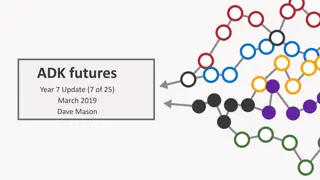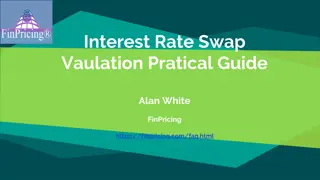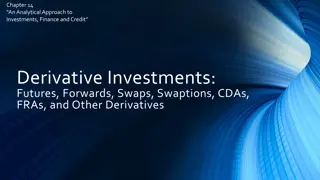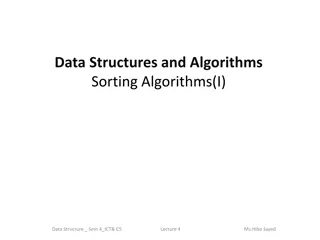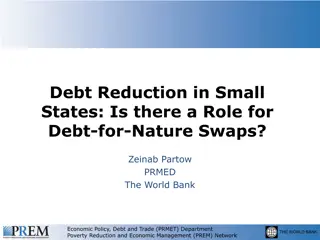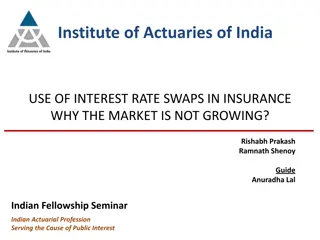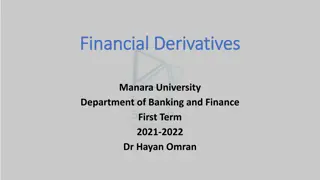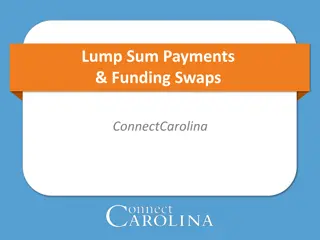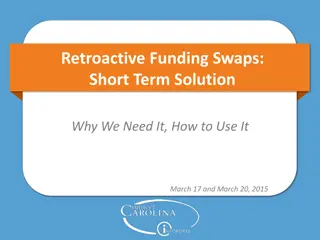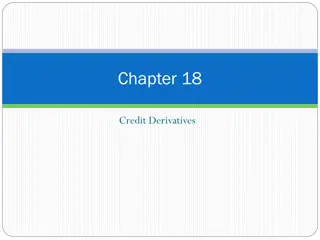Understanding Futures and Swaps in FX Markets
Exploring the world of FX derivatives such as futures, options, and swaps, with insights into how futures contracts differ from forward contracts, the concept of long squeezes in the oil market, and the risks associated with specific investment products like Crude Oil Treasure. Discover the intricacies of futures trading, including standardizing features, settlement processes, and the significance of open interest.
Download Presentation

Please find below an Image/Link to download the presentation.
The content on the website is provided AS IS for your information and personal use only. It may not be sold, licensed, or shared on other websites without obtaining consent from the author. Download presentation by click this link. If you encounter any issues during the download, it is possible that the publisher has removed the file from their server.
E N D
Presentation Transcript
Sections Futures Options Swaps
Futures contracts A futures contract is similar to a forward contract in that it specifies that a certain currency will be exchanged for another at a specified time in the future at prices specified today; i.e., an obligation. A futures contract is different from a forward contract in that futures are standardized contracts trading on organized exchanges with daily marked- to-market resettlement through a clearinghouse. Settle price: a price representative of futures transaction price at the end of daily trading, which is determined by a settlement committee.
Long squeeze: negative oil price At one point yesterday (04/20/2020), the May WTI(West Texas Intermediate) contract was selling for negative $30 or more. There were a number outstanding long contracts and today s expiration of the May contract meant that those holding them either had to take delivery or sell the equivalent amount of oil. With few buyers, selling the contract is difficult to impossible and many trading on the futures market have no ability to take delivery of the contract. Source: Forbes, 04/2020
Long squeeze(): Bank of China Oil is cheaper than water was the slogan for an investment product, called Crude Oil Treasure and sold by Bank of China, that was pegged to the price of petroleum. Investors in Crude Oil Treasure (a Bank of China oil futures product) lost (all) their money and then some. Because of a quirk in global oil markets, Bank of China said, Crude Oil Treasure investors owed the lender even more money, specifically $37.63 for every barrel they had bought. It is not clear how many people invested or how much they bought, but the bill for Bank of China could be as much as $1.4 billion, according to Shujin Chen, an analyst at the brokerage Jefferies, based on reports that the lender had 60,000 investors in the product. Source: NYT, 05/2020
Futures contracts: Preliminaries Standardizing features: Contract size Delivery month Daily resettlement Initial performance bond, i.e., margin (about 2 percent of contract value, cash or T-bills, held at your brokerage). Commission: buyers and sellers pay a single amount paid up front that covers the round-trip transactions of initiating and closing out the position. The commission can be as little as $15 per futures contract. Open interest: the total number of long or short contracts outstanding.
Currency futures markets The CME Group (formerly Chicago Mercantile Exchange) is by far the largest currency futures market. CME hours are 7:20 a.m. to 2:00 p.m. CST Monday-Friday. Extended-hours trading takes place Sunday through Thursday (local) on GLOBEX i.e. from 5:00 p.m. to 4:00 p.m. CST the next day. Expiration cycle: March, June, September, December. The delivery date is the third Wednesday of delivery month. The last trading day is the second business day preceding the delivery day.
Reading currency futures quotes OPEN INTEREST OPEN HIGH LOW SETTLE CHG Euro/US Dollar (CME) 125,000; $ per 1.3084 1.3118 June 1.3089 1.3126 Sept 1.3054 1.3062 1.3087 1.3094 .0005 .0006 233,380 6,814 In general, open interest decreases over time. At the June settlement price of 1.3087 (in American terms), the holder of a long (short) position in one futures contract is committing himself/herself to paying (receiving) $163,588 (1.3087 125000) for 125,000 on the delivery day. Futures can be used to hedge: you know for sure (risk reduction) about the price today, say 1.3087, for delivery in the future.
CME futures contract size EUR125,000 GBP62,500 JPY12,500,000 CNY1,000,000
Example Consider a long position in the CME euro contract. It is written on 125,000 and quoted in $ per . The purchase price is $1.30 per . The maturity is 3 months. At initiation of the contract, the long posts an initial performance bond of $6,500. The maintenance performance bond is $4,000. You get a margin call when your (equity) position erodes by $2,500. If you fail to do so, the position will be closed out with an offsetting short position.
Daily resettlement With futures contracts, we have daily resettlement of gains and losses rather than one big settlement at maturity. Futures payoffs are a zero-sum game. Every trading day: If the price goes down, the long pays the short. If the price goes up, the short pays the long.
Example - continued Over the first 3 days, the euro strengthens (from $1.30) then depreciates in dollar terms: Settle Gain/Loss Account Balance $1.31 $1,250 $7,750 = $6,500 + $1,250 $1.30 $1,250 $6,500 + $3,750 = $6,500 $1.27 $3,750 $2,750 On day 3, suppose our investor keeps his long position open. Then s/he needs to put in an additional $3,750.
Futures pricing The pricing of futures contracts is similar to that of forward contracts. Thus, we can use the interest rate parity (IRP) to price futures: In American terms, (F S) / S = (iD iF) / (1 + iD) iD iF
Speculating with futures Suppose that you took a long position today in one December euro futures at $1.3094/ . You hold it until it expires on the third Wednesday of December. The spot rate that day is $1.2939/ . The standard contract size is 125,000. Your speculative loss is (1.2939-1.3094) 125,000 = -$1,937.50. In contrast, if you had taken a short position, your speculative gain is $1,937.50.
Options contracts An option gives the holder the right, but not the obligation, to buy or sell a given quantity of an asset in the future at prices agreed upon today (i.e., exercise price). Calls vs. Puts: Call options give the holder the right, but not the obligation, to buy a given quantity of some asset at some time in the future at prices agreed upon today. Put options give the holder the right, but not the obligation, to sell a given quantity of some asset at some time in the future at prices agreed upon today.
Options European versus American options: European options can only be exercised on the expiration date while American options can be exercised at any time up to and including the expiration date. American options are usually worth more than European options, other things equal. Premium: option price; the cost of acquiring an option.
Options market The over-the-counter market written by international banks, investment banks, and brokerage houses is very active. Generally, these contracts are tailor-made and are written for large amounts, at least worth of $1 million of the currency serving as the underlying asset. These contracts are often European style. Philadelphia Stock Exchange (PHLX), part of the NASDAQ QMX Group, have currency options as well. But the trading volume is much smaller than that in the OTC market. Prices/FX rates are quoted in American terms.
PHLX currency option specifications Currency Australian dollar British pound Canadian dollar Euro Japanese yen New Zealand dollar Swiss franc Contract Size AUD 10,000 GBP 10,000 CAD 10,000 EUR 10,000 JPY 1,000,000 NZD 10,000 CHF 10,000
Option payoffs at expiration At expiration (T), an American option (a) is worth the same as a European option (e) with the same characteristics. In American terms, if the call is in-the-money, it is worth ST E., where ST is the spot rate at expiration, and E is the exercise price. If the call is out-of-the-money, it is worthless and its payoff, C, is: CaT = CeT = Max[ST E, 0] = 0 If the put is in-the-money, it is worth E ST. If the put is out-of-the-money, it is worthless and its payoff, P, is: PaT = PeT = Max[E ST, 0] = 0
Example Consider a PHLX 130 (i.e., 130 cents) Aug EUR European call option. The standard contract size is 10,000. The exercise price is $1.30 per . The contrast expires in August. The premium paid was 2.52 cents ($0.0252) per . Suppose the spot rate at expiration is $1.3425/ . The call has an exercise payoff of 10000 0.0425 (=1.3425 1.30) = $425. The call costs the investor 10000 0.0252 = $252. Thus, the profit (net terminal value; ignoring time value of money) for this trade is: 425 252 = $173. Now suppose that the spot rate at expiration is below $1.30/ . The investor will simply throw away this option and incur a loss for this trade in the amount of $252.
Call option profit profiles Profit If the call is in- the-money, it is worth ST E. If the call is out- of-the-money, it is worthless, and the buyer of the call loses his entire investment of premium c0. ST c0 E + c0 E In-the-money Out-of-the-money Loss
Put option profit profiles Profit If the put is in- the-money, it is worth E ST. The maximum gain is E p0 (p0 being premium). E p0 Short put If the put is out- of-the-money, it is worthless, and the buyer of the put loses his entire investment of p0. ST p0 Long put E p0 E In-the-money Out-of-the-money Loss
Danger: uncovered short From the above two graphs, you will notice that uncovered short of a call or a put entails almost unlimited amount of possible downside. Banks sometimes encourage their customers to underwrite uncovered short position to earn a fee without properly disclosing the intrinsic risk that their customers need to bear. Taiwan s central bank said this past week (in 2016) that it will require complex, high-risk Forex derivative instruments to go through regulatory approval before allowing banks to sell such products to clients, as first reported by Reuters.
*American call prior to expiration Payoff The red line shows the intrinsic value; i.e., the payoff of immediate exercise. Long call Intrinsic value Note that even an out-of-the-money option has value because of time value. ST Time value In-the-money Out-of-the-money E
Currency futures options Currency futures options are options on a currency futures contract. Exercise of a currency futures option results in a long futures position for the holder of a call or the writer of a put. Exercise of a currency futures option results in a short futures position for the seller of a call or the buyer of a put. If the futures position is not offset prior to its expiration, foreign currency will change hands.
Hedging with currency option Adamant Inc. of Vermont imports Italian wine. On November 1stit bids 62,500 for a batch of rare wine, but it will not know until December 15th whether the bid is accepted. To protect against a possible appreciation of , it purchases a 62,500 call option. The strike price is 1.2750 $/ and the option premium is 0.5 cent per euro. Thus the option costs $312.5 (= 62500 0.005).
Hedging outcomes If the euro appreciates to 1.3000 $/ , the payment without the option would be $81,250 (=62500 1.3). Adamant Inc. will surely exercise the option and purchase the euro for 1.2750, which is a payment of $79,687.5 (= 62500 1.275)+ premium of $312.5. If the euro depreciates to 1.2000 $/ , the firm will be better off buying euro on the spot market, so it lets the option expire unused. The payment is then $75,000 (= 62500 1.2) + premium of $312.5
Swaps Forwards, futures, and options have maturities mostly no longer than 1 year. Swaps are often used for multiple years. In a swap, two counterparties agree to a contractual arrangement wherein they will exchange (interest) cash flows at periodic intervals. There are two types of interest rate swaps. Single currency interest rate swap Plain vanilla fixed-for-floating swaps are often just called interest rate swaps. Cross-currency interest rate swap This is often called a currency swap; fixed for fixed rate debt service in two (or more) currencies.
Swap market The notional principal of: Interest rate swaps is about $400 trillion USD. Currency swaps is about $30 trillion USD. The most popular denominating currencies for swaps are: U.S. dollar Japanese yen Euro Swiss franc British pound sterling
Swap bank Swap bank is a generic term to describe a financial institution (international commercial bank, investment bank, or independent operator) that facilitates swaps between counterparties. The swap bank can serve as either a broker or a dealer (most likely a dealer nowadays). As a broker, the swap bank matches counterparties but does not assume any of the risks of the swap. As a dealer (market maker), the swap bank stands ready to accept either side of a currency swap and then later lay off the risk, or match it with a counterparty.
Swap products Swap banks can tailor the terms of interest rate and currency swaps to customers needs. They also make a market in plain vanilla (i.e., rather generic, standardized) swaps and provide quotes for these swaps. Since the swap banks are dealers for these swaps, there is a bid-ask spread.
Generic fixed-for-floating swap Consider a 5-year swap with semiannual payment 8.50-8.60 % against 6-month dollar LIBOR flat (The average interest rate at which a selection of banks in London are prepared to lend to one another in American dollars with a maturity of 6 months. Flat means no credit premium; i.e., the best rates for counterparty with the highest credit rating). Note: The Secured Overnight Financing Rate (SOFR), a broad measure of the cost of borrowing cash overnight collateralized by Treasury securities, is replacing LIBOR. The swap bank will pay semiannual fixed-rate dollar payments of APR 8.5% against receiving 6-month dollar LIBOR (of course, LIBOR is floating). The swap bank will receive semiannual fixed-rate dollar payments of APR 8.6% against paying 6-month dollar LIBOR. The spread of 0.1% is the revenue for the swap bank.
A case for interest rate swap, I Consider a AAA-rated regional bank A that needs $10 million to finance a floating-rate loan to its client. Interest rate risk management: for this financing, it is ideal for bank A to issue 5-year floating-rate notes (FRNs) indexed to LIBOR (floating-rate assets matched with floating-rate liability). Alternatively (presumably less ideal without a swap), bank A can issue 5-year fixed-rate bonds at 10%. The swap bank instructs bank A to do the alternative financing: issue fixed-rate bonds at 10%.
A case, II Company B is a BBB-rated manufacturing firm that needs $10 million to finance a new investment project with a life of 5 years. Maturity matching: ideally, company B prefers the issuance of 5-year fixed-rate bonds at 11.25%. Alternatively, company B can issue 5-year floating-rate notes at LIBOR + 0.5% (credit premium because of BBB). The swap bank instructs company B to do the alternative financing: issue floating-rate notes at LIBOR + 0.5%.
A case, III Bank A Swap Bank Firm B 10.375% 10.50% LIBOR LIBOR The swap bank performs a swap with bank A and company B being counterparties, set the prices at 10.375%-10.50%, and makes 0.125% on the deal. Note that the spread, 10.375% and 10.50%, are sandwiched by the fixed rates, 10.00% and 11.25%, bank A and company B are able to achieve.
A case, IV All-in cost (net cash outflows) for bank A: LIBOR 10.375% + 10% (the alternative fixed-rate bond APR) = LIBOR 0.375%. This is cheaper (by 0.375%) than the ideal LIBOR financing. All-in cost for company B: 10.50% - LIBOR + [LIBOR + 0.5% ] = 11%, where [LIBOR + 0.5%] is the alternative financing cost. 11% is cheaper (by 0.25%) than the ideal fixed-rate bond APR of 11.25%.
In short It is a win-win-win situation. Swap bank creates business. Bank A got its LIBOR cash flows with a saving of 0.375%. Company B got its fixed-rate cash flows with a saving of 0.25%. But how does this happen?
Quality spread differential In this case, quality spread differential exists. That is, the default-risk premium differential on the fixed-rate debt, 1.25% (= 11.25% - 10.00%), is larger than the default-risk premium differential on the floating-rate debt, 0.5% (= [LIBOR + 0.5%] - LIBOR). This creates a possible total saving of 0.75% ( = 1.25% - 0.5%). This 0.75% saving/efficiency is shared by the swap bank (0.125%), bank A (0.375%), and company B (0.25%). Bank A prefers floating-rate notes, but it has competitive advantage in issuing fixed-rate bonds.
To sum up Bank A Company B Rating AAA BBB Fixed rate cost 10% 11.25% Floating rate cost LIBOR LIBOR +0.5% Swap LIBOR 10.375% Swap Bank LIBOR 10.5% Net cash flow LIBOR 0.375% 11% Saving 0.375% 0.25%
A case for currency swap, I Consider a U.S. MNC desires to finance a new investment project in the amount of 40 million in Germany. This German operation has a life of 5 years. The current spot rate $/ = 1.30. FX risk management: ideally, the firm would prefer to issue - denominated 5-year fixed-rate bonds at 7%. Note that 7% is fairly high by the Eurozone s standard because the U.S. firm is less known in the Eurozone. Alternatively (presumably less ideal without a swap), the firm can raise $52 million (= 40 1.3) by issuing 5-year fixed-rate dollar bonds at 8%, then convert $52 million into 40 million. The swap bank instructs the U.S. firm to do the alternative financing: issue fixed-rate $-denominated bonds at 8% in the U.S.
A case, II A German MNC has a mirror-image financing need. It desires to finance a new investment project in the amount of $52 million in the U.S. This U.S. operation has a life of 5 years. FX risk management: ideally, the firm would prefer to issue $- denominated 5-year fixed-rate bonds at 9%. Note that 9% is fairly high by the American s standard because the German firm is less known in the U.S. Alternatively, the firm can raise 40 million by issuing 5-year fixed-rate -denominated bonds at 6%, then convert 40 million into $52 million (= 40 1.3). The swap bank instructs the firm to do the alternative financing: issue fixed-rate -denominated bonds in the Eurozone at 6%.
A case, III U.S. MNC Swap Bank German MNC $ @ 8% $ @ 8.1% @ 6.1% @6% The swap bank performs a swap with bank A and company B being counterparties, and makes 0.2% on the deal.
A case, IV All-in cost (net cash outflows) for the U.S. MNC s borrowing via swap: 6.1%. This is cheaper (by 0.9%) than the ideal 7% borrowing. All-in cost for the German MNC: 8.1%. This is cheaper (by 0.9%) than the ideal 9% $ borrowing. The efficiency arises because the U.S. MNC has comparative advantage issuing debt in the U.S., and the German MNC has comparative advantage issuing debt in the Eurozone.
To sum up US Firm German Firm $ fixed rate cost $ @ 8% $ @ 9% @ 6% fixed rate cost @ 7% Swap $ @ 8% @ 6.1% Swap Bank $ @ 8.1% @ 6.0% Net cash flow @ 6.1% $ @ 8.1% Saving @ 0.9% $ @ 0.9%
End-of-chapter Chapter 7 Questions 1, 2, 5, 6; Problems 1, 2, 4-8. Chapter 14 Questions 1-3, 5, 9; Problems 1-3, 8.




